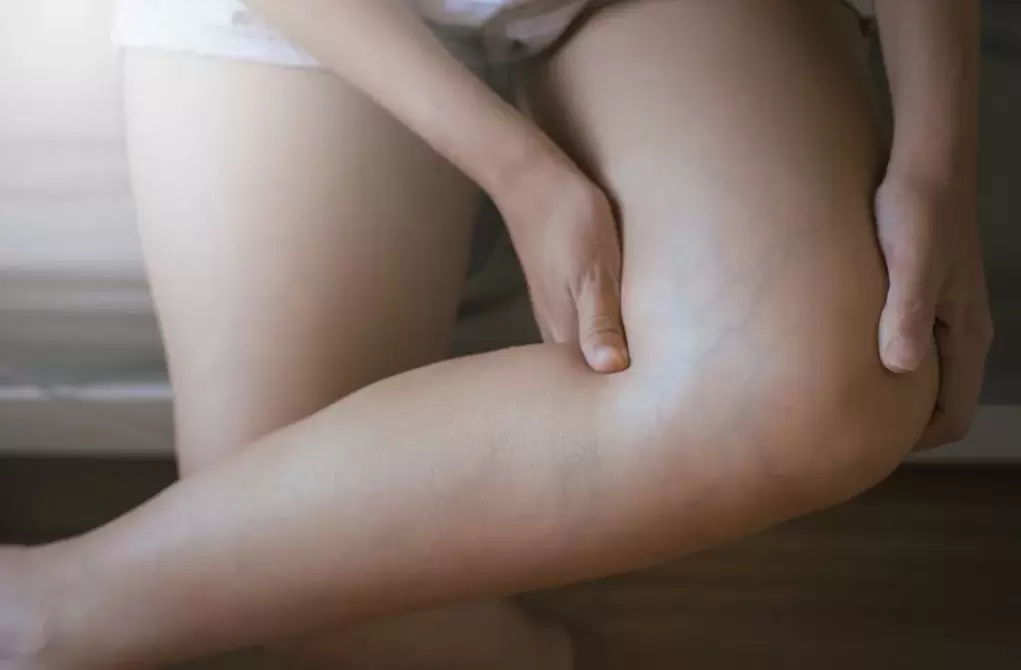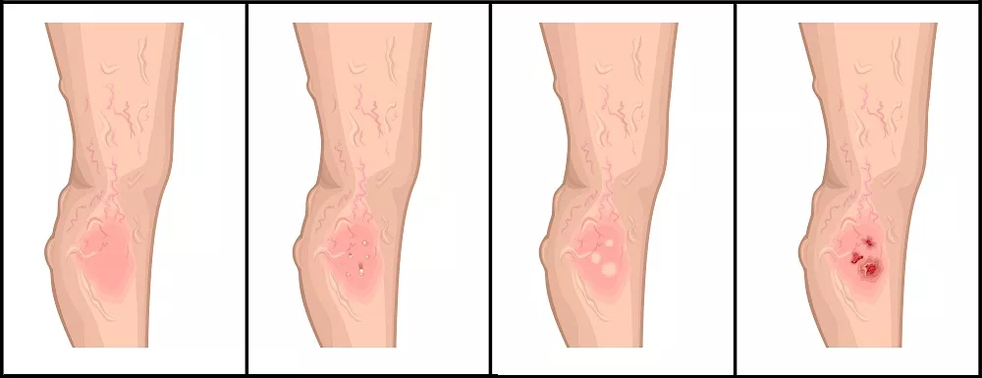
What are varicose veins and how do they manifest? What happens if you do not treat varicose veins and how to prevent it? We talk about the complications of varicose veins, we explain in detail why trophic ulcers appear and why compression stockings are necessary.
What are varicose veins and how do they manifest?
Veins have special valves that prevent blood from flowing through the vessels. But with varicose veins, these valves don't close completely: blood pools in the vein, stretching it.
Symptoms of varicose veins in the initial stages:
- Leg veins become brighter, more visible;
- On the inner surface of the legs and thighs, varicose nodes begin to appear;
- If you stand, sit or walk for a long time, you feel heaviness in the legs, a feeling of fullness (more often at night, in the calves);
- In the places of expansion of the veins, pain or sharp pain appears, in the evening and at night - cramps in the calf muscles;
- The legs are very swollen at the end of the day, but in the morning the swelling goes away.
Important!
Already at this stage it is necessary to consult a doctor.
With progression, varicose veins become chronic (chronic venous insufficiency). Symptoms:
- Strongly tortuous dark blue intradermal veins appear: protruding above the surface of the legs and feet, they look like bunches of overripe red grapes;
- There is arch pain in the legs and calves, a feeling of heat in the legs, night cramps in the calf muscles, severe swelling;
- The skin dries out, pigmentation appears, it becomes darker, brown spots appear.
Important!
Don't start the disease! With varicose veins, the nutrition of the tissues is disrupted. There is not enough nutrition for the vessels and skin - wounds, eczema and even ulcers appear, which heal very poorly.
Varicose vein treatment
There are two ways to treat varicose veins: conservative and surgical.
- Conservative: compression therapy. Compression underwear squeezes the affected leg: the diameter of the superficial veins decreases, the correct pressure in the vein is restored. The return of blood decreases, the walls of the vessels remain in good condition, the valves close, the blood does not stagnate and circulates well, the speed of blood movement through the deep veins increases. The volume of stagnant blood decreases, improves lymph flow.
- In advanced cases, when conservative treatment does not help, the doctor will suggest a surgical way: varicose nodes are removed, the affected veins are removed. To restore functions, shunts are placed or the mobility of the valve is restored so that it closes its leaflets.
Compression knitwear for varicose veins and ulcers
Compression stockings are special stockings that fit snugly around the lower leg and loosen as they go up the thigh. This improves blood circulation and stimulates blood flow from the lower extremities to the heart.
Compression stockings are selected individually, so consult a phlebologist first - you cannot choose stockings on your own.
The phlebologist will look at the tone of the vein, in which particular valve there is a problem with the valves not closing. The problem may be, for example, in the thigh: then you need to wear compression stockings. If there is a problem with the closure of the valve below the knee, then socks or stockings are selected.
Important!
For maximum effectiveness, compression stockings should be worn at all times; they should only be removed at bedtime.
How to put on compression stockings?
- After waking up, put your legs on the wall and lie down like that for a while, so that the blood flows to the hips as much as possible;
- Without getting up, put on compression stockings.
In this position (lying down, legs raised), the blood supply is leveled, the blood does not stagnate. When the compression stockings are on the legs, the veins are in good shape and the valves close well and push blood further through the vessels.
What happens if varicose veins are not treated?
If you do not start treatment for varicose veins on time, life-threatening complications can occur:
thrombophlebitis- inflammation of the vein due to the formation of blood clots in it. Symptoms:
- redness;
- the place where the thrombus is located is heated;
- a swollen vein hurts a lot.
If timely treatment is started, the thrombus will stop growing. Residual blood clots can resolve for a long time, sometimes months. If left untreated or done incorrectly, the clot can grow.
Pulmonary embolism.The thrombus that appeared with thrombophlebitis detaches from the vessel wall in the leg and goes out with the bloodstream. It obstructs the pulmonary artery or its branches, this is fatal. Unfortunately, even having suspected this complication in time, doctors cannot do anything about it.
Symptoms:
- Chest pain;
- fast heartbeat;
- dyspnoea;
- unreasonable anxiety and feeling of unreasonable fear.
Deep vein thrombosis of the lower extremities. This is a serious and dangerous complication of varicose veins. The internal veins are clogged, because of this the outflow of blood almost completely stops - all the tissues of the leg do not receive nutrition and turn blue.
Venous gangrene of the extremities- severe deep vein thrombosis, in which there is no nutrition of the limb, arterial blood flow is disturbed. Due to the fact that the blood does not flow, gangrene forms - the leg, in fact, dies, starting with the fingers.
trophic ulcers- long-term non-healing ulcers that occur due to malnutrition of the tissues. The lymph stagnates in the lymphatic vessels, they experience a large load and cannot cope with the amount of lymph. Therefore, lymph droplets begin to protrude through the skin. Because of this, the epidermis begins to exfoliate - an ulcer with dense, uneven edges is formed. Any touch causes him severe pain.
Bacteria quickly develop in ulcers: an infection joins, a bleeding ulcer begins to suppurate. This can lead to very serious complications, including blood poisoning.

Trophic ulcers are of two types:
- venous, when the subcutaneous and deep veins of the limb are affected;
- arterial, when the arteries of the leg are affected and the natural nutrition of the extremities is disturbed.
Treatment of trophic ulcers
Trophic ulcers are treated with elastic compression, medications, physical therapy, and surgery.
The care of trophic ulcers includes four stages.
The first stage - antiseptics.
- Antiseptic solution for the treatment of wounds. It is applied to the surface of a trophic ulcer, if cavities have formed under the skin, they are also filled with gel.
- The gel, which has an antimicrobial and anti-inflammatory effect, improves microcirculation, reduces redness and swelling of the skin, reduces pain, relieves itching and peeling of the skin, blocks the spread of infections and prevents the formation of scars. .
- An aqueous solution of an antiseptic of the halogen group or benzyldimethyl-myristoylamino-propylammonium.
The second stage - gels to soften dead tissue
The dead tissue is necrosis: hardened black tissue on the surface of the ulcer. If it is not removed, the ulcer will not heal. To do this, the necrosis is first softened. This is done using special gels.
The third stage is the formation of an optimal environment for wound healing.
Healing is facilitated by creating a moist wound environment. If there is no necrosis, use bandages for quick healing. Here are some bandages that will fit:
Alginate dressings:
- An alginate dressing that turns into a soft gel on contact with wound secretions, providing optimal conditions for moist wound healing;
- A dressing that fills the wound cavity and creates a microenvironment that promotes rapid healing;
- Sponge bandage with hydrogel layer. Its structure absorbs secretions and maintains a moist environment in the wound;
- Alginate sponge dressing composed of calcium alginate and hydrocolloid;
- Self-absorbing sterile coating based on sodium alginate, very suitable for wounds and burns, accelerates healing;
- Hydroactive dressing for deep wounds. Cleans the wound, accelerates its healing, maintains an optimal environment in the wound for up to three days without changing the dressing.
Sponge bandages:
- Double-sided foam bandage. Protects the wound, absorbs secretion from the wound, creates an optimal water balance in the wound;
- Hydrophilic polyurethane sponge dressing;
- A dressing with a complex of enzymes and chitosan is suitable for infected wounds (if there is pus in the wound);
- Breathable antimicrobial sponge dressing consisting of a polyurethane sponge layer and a silver alginate matrix.
Fourth stage - wound healing
When the wound has been cleaned and an optimal environment has been formed in it, it begins to heal, the edges of the wound shrink. For safe and quick healing, use special dressings.
Mesh ointment bandages:
- Ointment bandage with balsam of Peru to apply when fresh skin appears on the wound;
- Ointment dressing based on triglycerides, which promotes healing and cares for the edges of the wound;
- The bandage, which looks like a square of wax, is soft and quite dense. It can be on the wound for up to seven days;
Film dressings that can be used to fix wound dressings:
- Water-repellent (but breathable) film bandage, protects the wound from microorganisms. It can be used to fix previous bandages and as a stand-alone bandage.
- Transparent film polyurethane bandage, the skin under it does not sweat, it breathes.
Important!
These dressings are suitable for healing not only trophic ulcers, but also any long-healing wounds.
Prevention of varicose veins
- Move as much as you can: the more you move, the better the blood will circulate through the veins;
- Give up bad habits;
- Contact a phlebologist in time at the first symptoms of the disease;
- Periodically do an ultrasound of the vessels - the doctor will notice the first changes;
- After a day at work, come home and lie down with your feet on the wall for about 15 minutes.
Prevention of trophic ulcers
- Take care of your weight: it puts pressure on your legs, loads the vascular and lymphatic systems. If necessary, follow the diet;
- Walk as often as possible;
- If possible, raise your legs, keep them in an elevated position as often as possible. In the evening, you can lie on the sofa and raise your legs, putting them on the wall - you need to lie like this for at least 15 minutes;
- Treat the veins of the lower extremities in time;
- Quit smoking - greatly reduces the blood supply to the tissues and contributes to the development of trophic ulcers;
- Take care of your feet: wear suitable footwear so that they do not itch or rub;
- Examine your feet regularly: Check the color of the skin on your feet. If the legs turn blue at night and veins are visible on the legs, contact a phlebologist;
- Moisturize the skin with softening, moisturizing and nourishing creams;
- Keep your feet warm, dress for the weather;
- Try not to injure the skin.


















